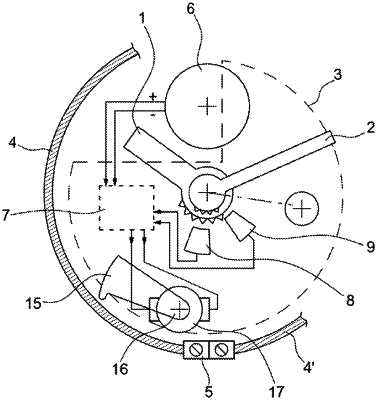| CPC G04C 21/06 (2013.01) | 13 Claims |

|
1. A watch provided with a striking mechanism, the mechanism comprising at least one gong attached (4) to a gong-carrier (5), and at least one hammer (15) intended to activate the gong to vibrate it, wherein the striking mechanism further comprises:
an electric energy accumulator (6),
an integrated circuit (7) powered by the electric energy accumulator (6) and configured to produce at least one current pulse,
an electrodynamic actuator (17) which is connected to the integrated circuit and which is able to receive said pulse(s), the actuator comprising a magnet (25) integral with the hammer (15) or connected to the hammer so as to generate in response to at least one current pulse (31) an oscillation (30) of the hammer (15) from the rest position, and wherein the impact happens approximately when the speed of the hammer during said oscillation is maximum, the actuator also comprising a coil (28) surrounding the magnet (25) and which receives said pulse(s), the oscillation being able to actuate an impact of the hammer on the gong (4), and
a return means (27) connected on the one hand to a plate (26) of the watch and on the other hand to the magnet (25) connected to the hammer (15) so as to return the hammer to its rest position after the impact,
wherein the integrated circuit (7) is configured to produce a series of pulses of opposite signs so that:
the hammer (15) undergoes at least two oscillations before reaching the impact, at least one of which is designated ‘pre-oscillation’, the pre-oscillation(s) being followed by a final oscillation which leads to the impact,
from the second pulse, each pulse is applied approximately when the hammer reaches the extreme point of the oscillation generated by the previous pulse, and
the magnitude of the pulses that generate the pre-oscillations is equal to or less than the magnitude of the pulse that generates the final oscillation.
|